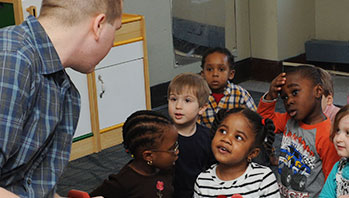- CDs
- flashlight (optional)
- color
- light (n)
- rainbow
MA Standards:
Speaking and Listening: SL.PK.MA.1: Participate in collaborative conversations with diverse partners during daily routines and play.
Language: L.PK.MA.1: Demonstrate use of oral language in informal everyday activities.
Language: L.PK.MA.6: Use words and phrases acquired through conversations, listening to books read aloud, activities, and play.
MA Draft STE Standards:
PS4.D: Compare and sort materials into those that allow all, some, or no light to pass through them. [Cause and Effect]
Head Start Outcomes:
Language Development/Receptive Language: Attends to language during conversations, songs, stories, or other learning experiences.
Language Development/Expressive Language: Uses language to express ideas and needs.
PreK Learning Guidelines:
English Language Arts/Language 2: Participate actively in discussions, listen to the ideas of others, and ask and answer relevant questions.
Talk Together: Rainbow CDs

© Commonwealth of Massachusetts, Department of Early Education and Care (Jennifer Waddell photographer). All rights reserved.
STEM Key Concepts: There are many different colors
ELA Focus Skills: Speaking and Listening, Vocabulary
Review what children know about rainbows. Explain what causes a rainbow to appear: When we see a rainbow, we are seeing white light being separated. As light travels through rain, mist, or the spray from a garden hose, it bends. When the light bends, each visible wavelength bends at a different angle, so they separate and we can see their colors: red, orange, yellow, green, blue, and violet.
Hold up a CD and describe what it is and explain that, when light hits the reflective, (silvery) plastic-coated aluminum on the backside of the CD, tiny ridges break up the white light. Then tell children they are going to use a CD to make a rainbow.
- Show children an old CD (one that can be handled without fear of damage). Turn it over so the smooth, very reflective underside is showing.
- Model how to move it slowly so it catches the light from overhead lights or incoming sunlight. Ask, What colors do you see?
- Make the colors even bigger and brighter by darkening the room. Before shining a flashlight on the CD, ask, What do you think will happen when I shine the flashlight on the CD? Do you think the colors will be the same or different?
Give each child a CD so he or she can explore making rainbows. Help younger children hold the CDs as needed.
- Say, I wonder what colors you will see in your rainbows. Record children’s ideas.
- After children are finished exploring, ask, What colors did you see in your rainbow? Let’s compare what you saw to what we thought we would see. Discuss children’s observations.
